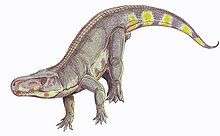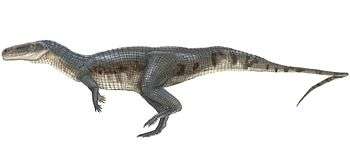Prestosuchidae
| Prestosuchidae Temporal range: Middle - Late Triassic, 245–216 Ma | |
|---|---|
 | |
| Mounted skeleton of Prestosuchus at the American Museum of Natural History. | |
| Scientific classification | |
| Kingdom: | Animalia |
| Phylum: | Chordata |
| Class: | Reptilia |
| Clade: | Loricata |
| Family: | †Prestosuchidae Romer, 1966 |
| Genera | |
Prestosuchids were a group of Triassic carnivorous archosaurs. They were large active terrestrial apex predators, ranging from around 2.5 to 7 metres (8.2 to 23.0 ft) in length. They succeeded the Erythrosuchidae as the largest archosaurs of their time. While resembling erythrosuchids in size and some features of the skull and skeleton, they were more advanced in their erect posture and crocodile-like ankle, indicating more efficient gait. Prestosuchids flourished throughout the whole of the middle, and the early part of the late Triassic, and fossils are so far known from Europe, India, Africa (Tanganyika), Argentina, and Paleorrota in Brazil. However, experts disagree regarding the phylogenetic relationships of the group, what genera should be included, and whether indeed the Prestosuchidae constitute a distinct family apart from the Rauisuchidae.
Classification
In 1957, Alan Charig proposed a new family, the Prestosuchidae, to include genera like Mandasuchus, Prestosuchus, and Spondylosoma.[1]
In 1967, Alfred Sherwood Romer placed Saurosuchus and Rauisuchus within Erythrosuchidae and adopted the Prestosuchidae to include Prestosuchus, Procerosuchus, and Charig's "Mandasuchus".
Prestosuchidae have often been included within Rauisuchidae,[2][3][4] although they have sometimes considered the sister group of the aetosaurs in a monophyletic Pseudosuchia,[5] or as a small clade intermediate between basal Crurotarsi and more advanced archosaurs such as the Aetosauridae and Rauisuchidae.[6] J. Michael Parrish's 1993 cladistic analysis of crocodylotarsan archosaurs places the Prestosuchidae (including Prestosuchus, Ticinosuchus, and Saurosuchus) outside the crocodylomorph - poposaurid - rauisuchid - aetosaur clade.[7] In most cladograms Prestosuchids are considered more derived than phytosaurs and ornithosuchids, but usually less derived than the poposaurids and aetosaurs.
Evolution of the group
The earliest known prestosuchid is Mandasuchus from the Anisian of Tanganyika. This was already a large animal, about 4.75 meters long.[8] A similar but smaller form (perhaps the same genus) is Ticinosuchus of the Middle Triassic (Anisian-Ladinian) of Switzerland and Northern Italy, which was about 2.5 meters in length. The huge (6 meters long) Batrachotomus from the latest Middle Triassic (Late Ladinian) of Germany, and Prestosuchus of the early Late Triassic (Carnian) of Brazil may have been closely related animals.[6] Yarasuchus was a lightly built animal from the Middle Triassic of India that also seems to belong to this group.[9] Finally, Saurosuchus was a huge carnivore, 6 or 7 meters long, whose fossils are known from the Late Carnian of Argentina.
List of genera
| Genus | Authors | Year | Status | Age | Location | Unit | Description | Images |
|---|---|---|---|---|---|---|---|---|
| Gower | 1999 | Valid | Late Ladinian | |
Kupferzell, Crailsheim and Vellberg-Eschenau |  | ||
| França Ferigolo Langer |
2011 | Valid | Ladinian | |
Santa Maria Formation |  | ||
| Kischlat | 2000 | Junior synonym | Middle Triassic | |
Santa Maria Formation | Probable synonym of Prestosuchus | ||
| Charig | 1957 | Nomen nudum | Middle Triassic | |
Manda Formation | Nomen nudum, probable synonym of Ticinosuchus | ||
| Huene | 1942 | Valid | Late Triassic | |
Santa Maria Formation |  | ||
| Reig | 1959 | Valid | Late Carnian | |
Ischigualasto Formation |  | ||
| Krebs | 1965 | Valid | Late Anisian | |
Mittlere Grenzbitumenzone |  | ||
References
- ↑ Charig, A. J. (1957). "New Triassic archosaurs from Tanganyika, including Mandasuchus and Teleocrater". Dissertation Abstracts, Cambridge University.
- ↑ Gauthier, J. A. (1986). "Saurischian monophyly and the origin of birds". Memoirs of the California Academy of Sciences. 8: 1–55.
- ↑ Benton, M. J.; Clark, J. M. (1988). "Archosaur phylogeny and the relationships of the Crocodilia". In M. J. Benton (ed.). The Phylogeny and Classification of the Tetrapods. 1. Oxford: Systematics Association. pp. 295–338. ISBN 0-19-857712-5.
- ↑ Benton, M. J.; Walker, A. D. (2002). "Erpetosuchus, a crocodile-like basal archosaur from the Late Triassic of Elgin, Scotland". Zoological Journal of the Linnean Society. 136: 25–47. doi:10.1046/j.1096-3642.2002.00024.x.
- ↑ Juul, L. (1994). "The phylogeny of basal archosaurs". Palaeontologia Africana. 31: 1–38.
- 1 2 Gower, D. J. (2002). "Braincase evolution in suchian archosaurs (Reptilia: Diapsida): evidence from the rauisuchian Batrachotomus kupferzellensis". Zoological Journal of the Linnean Society. 136: 49–76. doi:10.1046/j.1096-3642.2002.00025.x.
- ↑ Parrish, J. M. (1993). "Phylogeny of the Crocodylotarsi, with reference to archosaurian and crurotarsan monophyly". Journal of Vertebrate Paleontology. 13 (3): 287–308. doi:10.1080/02724634.1993.10011511.
- ↑ Charig, A. J.; Krebs, B.; Sues, H.-D.; Westphal, F. (1976). "Thecodontia". Handbook of Paleoherpetology. Munchen: Verlag Dr. Friedrich Pfeil.
- ↑ Sen, K. (2005). "A new rauisuchian archosaur from the Middle Triassic of India". Palaeontology. 48 (1): 185–196. doi:10.1111/j.1475-4983.2004.00438.x.
- Sereno, P. C. 2005. Stem Archosauria—TaxonSearch [version 1.0, 7 November 2005]




